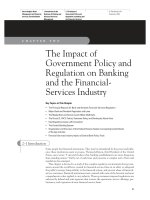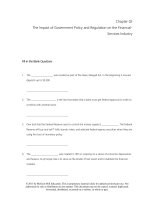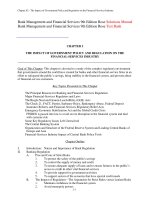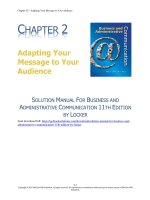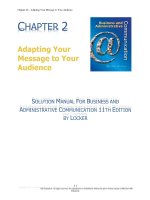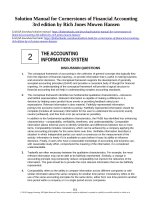Solution manual bank management and financial services 9th edition by rose, peter chap012
Bạn đang xem bản rút gọn của tài liệu. Xem và tải ngay bản đầy đủ của tài liệu tại đây (107.39 KB, 12 trang )
Chapter 12 - Managing and Pricing Deposit Services
CHAPTER 12
MANAGING AND PRICING DEPOSIT SERVICES
Goal of This Chapter: This chapter has multiple goals. One of the most important is to learn
about the different types of deposits financial institutions offer and, from the perspective of a
manager, to discover which types of deposits are among the most profitable to offer their
customers. We also want to explore how an institution’s cost of funding can be determined and
examine the different methods open to institutions to price the deposits and deposit-related
services they sell to the public.
Key Topics in This Chapter
Types of Deposit Accounts Offered
The Changing Mix of Deposits and Deposit Costs
Pricing Deposit Services
Conditional Deposit Pricing
Rules for Deposit Insurance Coverage
Disclosure of Deposit Terms
Lifeline Banking
Chapter Outline
I.
II.
III.
Introduction
Types of Deposits Offered by Depository Institutions
A.
Transaction (Payments or Demand) Deposits
1.
Noninterest-Bearing Transaction (Demand) Deposits
2.
Interest-Bearing Transaction Deposits
a.
Negotiable Order Of Withdrawal (NOW) Accounts
b.
Money Market Deposit Accounts (MMDAs)
c.
Super NOWs (SNOWs)
3.
Mobile Apps—Impact on Transaction Deposits and Potential Customers
B.
Nontransaction (Savings or Thrift) Deposits
1.
Passbook Savings Deposits
2.
Time Deposits
C.
Retirement Savings Deposits
1.
Individual Retirement Accounts (IRAs)
2.
Keogh Plans
3.
Roth IRAs
Interest Rates Offered on Different Types of Deposits
A.
The Composition of Deposits
1.
Trend toward Interest-Bearing and Nontransaction Deposits
2.
The Importance of Core Deposits
3.
Changes in the Relative Importance of Mix of Deposits
12-1
Chapter 12 - Managing and Pricing Deposit Services
IV.
V.
VI
VII.
VIII.
IX.
X.
B.
The Ownership of Deposits
C.
The Cost of Different Deposit Accounts
Pricing Deposit-Related Services
Pricing Deposits at Cost Plus Profit Margin
A.
Estimating Deposit Service Costs
New Deposit Insurance Rules–Insights and Issues
Using Marginal Cost to Set Interest Rates on Deposits
A.
Conditional Pricing
Pricing Based on the Total Customer Relationship and Choosing a Depository
A.
The Role That Pricing and Other Factors Play When Customers Choose a
Depository Institution to Hold Their Accounts
Basic (Lifeline) Banking: Key Services for Low-Income Customers
Summary of the Chapter
Concept Checks
12-1. What are the major types of deposit plans that depository institutions offer today?
Deposit plans can be divided broadly into transaction deposits, thrift or nontransaction deposits,
and retirement savings deposits. The primary function of transaction deposits is to make
immediate payments to the customers and these deposits include regular checking accounts,
market deposit accounts, NOW accounts, and mobile check deposit. The principal function of
thrift deposits is to serve as accumulated savings accounts and pay significantly higher interest
rates than transaction deposits do. Thrift deposits include passbook and statement savings
accounts, certificates of deposits (CDs), and other time deposit accounts. Retirement savings
deposits are an instrument especially for wage earners and salaried individuals. Some of the
accounts in the retirement savings deposits are IRAs and Keogh plan retirement accounts.
12-2. What are core deposits, and why are they so important today?
Core deposits are the most stable components of a depositary institution’s funding base and
usually include smaller-denomination savings and third-party payments accounts. They are
characterized by relatively low interest-rate elasticity. Holding a substantial proportion of core
deposits has an advantage in having access to a stable and cheaper source of funding with a
relatively low interest-rate risk.
12-3. How has the composition of deposits changed in recent years?
There has been a shift in the public’s holdings of deposits toward greater relative proportions of
the highest-yielding time and savings deposits such as combination of interest-bearing and
nontransaction deposits. Regular demand deposits which make up the majority of transaction and
noninterest-bearing deposits have declined significantly to less than 10 percent of total deposits
inside the United States.
12-2
Chapter 12 - Managing and Pricing Deposit Services
A combination of inflation, deregulation, stiff competition, and better-educated customers has
resulted in a dramatic shift in the mix of deposits that depository institutions are able to sell,
including a drastic decline in core deposits.
12-4. What are the consequences for the management and performance of depository
institutions resulting from recent changes in deposit composition?
While depository institutions would prefer to sell only the cheapest deposits to the public, it is
the predominant public preference that determines which types of deposits will be created.
Institutions that do not wish to conform to customer preferences will simply be outbid for
deposits by those who do. Managers who fail to stay abreast of changes in their competitors’
deposit pricing and marketing programs stand to lose both customers and profits.
Also, being faced with substantial interest cost pressures, many financial managers have pushed
hard to reduce their institution’s noninterest expenses (e.g., by automating their operations and
reducing the number of employees on the payroll).
12-5. Which deposits are the least costly for depository institutions? The most costly?
Commercial checkable deposits, particularly regular noninterest bearing demand deposits, are
usually the least costly. The most costly deposits are nontransaction, thrift deposit services
having substantial deposit and withdrawal activity and higher interest-rate time deposits.
12-6. Describe the essential differences between the following deposit pricing methods in use
today: cost-plus pricing, conditional pricing, and relationship pricing.
Cost-plus deposit pricing encourages banks to determine what costs they are incurring in labor
and management time, materials, etc., in offering each deposit service. Cost-plus pricing
generally calls for a bank to charge deposit service fees adequate to cover all the costs of offering
the service plus a small margin for profit.
Conditional pricing is used today as a tool by banks to attract the kinds of depositors they want to
have as customers. With this pricing technique a bank will post a schedule of offered interest
rates or fees assessed for deposits of varying sizes and based on account activity. Generally
larger volume deposits carry higher interest returns to the depositor or are assessed lower service
charges, encouraging customers to hold a high average deposit balance which gives the bank
more funds to invest in earning assets.
Finally, relationship pricing involves basing fees charged to a customer on the number of
services and the intensity of use of services the customer purchases from a bank.
12-7. A bank determines from an analysis of its cost-accounting figures that for each $500
minimum-balance checking account it sells, account processing and other operating costs will
average $4.87 per month and overhead expenses will run an average of $1.21 per month. The
bank hopes to achieve a profit margin over these particular costs of 10 percent of total monthly
costs. What monthly fee should it charge a customer who opens one of these checking accounts?
12-3
Chapter 12 - Managing and Pricing Deposit Services
The relevant formula is:
Unit price charged the customer for each deposit service =
Operating expense per unit of deposit service +
Estimated overhead expense allocated to the deposit-service function +
Planned profit margin from each service unit sold
In this case, the unit price charged per month should be $6.69 ($4.87 + $1.21 + [0.10 × ($4.87 +
$1.21)]) for each $500 minimum-balance checking account it sells.
12-8. To price deposits successfully, service providers must know their costs. How are these
costs determined using the historical average cost approach? The marginal cost of funds
approach? What are the advantages and disadvantages of each approach?
The historical average cost approach looks at the past. It asks the following question:
What funds has the bank raised to date and what did they cost? The marginal cost deposit-pricing
method focuses upon the weighted average cost of new funds raised from all of the different
sources of funds the bank draws upon or plans to draw upon in the current period. Under
marginal cost pricing, the offering institution will set its price at a level just sufficient to attract
new funds and still earn a profit on the last dollar of new funds raised.
The major advantage of marginal cost is that the marginal cost approach provides valuable
information to the managers of depository institutions, not only about setting deposit interest
rates, but also about deciding just how far the institution should go in expanding its deposit base
before the added cost of deposit growth catches up with additional revenues, and total profits
begin to decline. When profits start to fall, management needs either to find new sources of
funding with lower marginal costs, or to identify new assets promising greater marginal
revenues, or both.
The marginal cost is preferred over historical average cost as frequent changes in interest rates
will make historical average cost a treacherous standard for pricing.
12-9. How can the historical average cost and marginal cost of funds approaches be used to
help select assets (such as loans) that a depository institution might wish to acquire?
The historical average cost rate is called break-even because the institution must earn at least this
rate on its earning assets (primarily loans and securities) just to meet the total operating costs of
raising borrowed funds and the stockholders' required rate of return. Therefore, the institution
will know the lowest rate of return that it can afford to earn on assets it might wish to acquire.
The marginal cost of funds approach can be used as a guide to select loans and other assets
because the institution interested in profit maximizing would want to be sure to cover its fundraising costs.
12-10. What factors do household depositors rank most highly in choosing a financial firm for
their checking account? Their savings account? What about business firms?
12-4
Chapter 12 - Managing and Pricing Deposit Services
Studies cited in this chapter indicate that households (individuals and families) appear to
consider, in rank order, the following factors in choosing an institution to hold their checking
account: convenient location, availability of other services, safety, low fees and low minimum
balances, and high deposit interest rates. In selecting an institution to hold their savings account,
households appear to consider, in rank order: familiarity, interest rate paid, transactional
convenience, location, availability of payroll deduction, and any fees charged. Business firms, on
the other hand, seem to consider such factors as the financial health of the lending institution,
whether the institution will be a reliable source of credit in the future, the quality of bank
managers, whether loans are competitively priced, the quality of financial advice given, and
whether cash management and operations services are provided.
12-11. What does the 1991 Truth in Savings Act require financial firms selling deposits inside
the United States to tell their customers?
The 1991 Truth in Savings Act requires financial firms to fully inform their deposit customers on
the terms offered to each depositor. The customer must be told when a new account is opened or
if a deposit is renewed, what annual percentage yield (APY) is being offered and what minimum
balance is required to receive that yield. Moreover, the depositor must be informed about any
penalties or service fees which could reduce his or her expected yield. If the terms of a deposit
are changed in a way that would reduce the depositor's return, advance notice must be given to
the account holder.
12-12. Use the APY formula required by the Truth in Savings Act for the following calculation.
Suppose that a customer holds a savings deposit in a savings bank for a year. The balance in the
account stood at $2,000 for 180 days and $100 for the remaining days in the year. If the Savings
bank paid this depositor $8.50 in interest earnings for the year, what APY did this customer
receive?
The average account balance is:
$2,000 180 days $100 185 days
$1,036.99 .
365 days
The formula to find the APY is:
365
Days in period
Interest earned
APY 100 1
-1
Average account balance
In this instance,
365
$8.50 365
APY 100 1
1
$1,036.99
12-5
Chapter 12 - Managing and Pricing Deposit Services
APY = 0.82 percent.
12-13. What is lifeline banking? What pressures does it impose on the managers of banks and
other financial institutions?
Lifeline banking refers to basic service packages offered by banks to customers not generally
able to afford conventional bank service offerings. The essence of these services is that they
carry low service fees and usually do not offer all of the features of banking services carrying full
service fees. The pressure on managers to offer basic or lifeline services has aroused a big
controversy. From a profit motive point of view, banks should not offer unprofitable services. On
the other hand, financial institutions are partially subsidized by government in the form of lowinterest loans and deposit insurance and, therefore, have some public-service responsibilities
which may include providing certain basic services to all potential customers, regardless of their
income or social status. The managers of banks are imposed with such questions as to how they
should decide which customers should have access to low-price services, whether insisting on
imposing a means test on such customers can be allowed or not, and someone must bear the cost
of providing such services.
12-14. Should lifeline banking be offered to low-income customers? Why or why not?
This is not an easy question to answer. One of the most serious problems individuals outside the
financial mainstream face is lack of access to a deposit account. Lifeline banking is providing
basic banking services to these individuals. Most financial-service providers are privately owned
corporations responsible to their stockholders to earn competitive returns on invested capital.
Providing financial services at prices so low, that they cannot even cover costs, can interfere with
the financial institution’s important profit-making goal. Thus, from a profit motive point of view
banks should not offer unprofitable services.
However, it should be considered that depository institutions receive important aid from the
government that grants them a competitive advantage over other financial institutions like
deposit insurance. Therefore, they have some public-service responsibilities which may include
providing certain basic services to all potential customers.
Problems and Projects
12-1. Rhinestone National Bank reports the following figures in its current Report of
Condition:
Assets (millions)
Cash and interbank
deposits
Short-term security
investments
Total loans, gross
Long-term securities
Liabilities and Equity (millions)
$50 Core deposits
15 Large negotiable CDs
400 Deposits placed by brokers
150 Other deposits
12-6
$50
150
65
45
Chapter 12 - Managing and Pricing Deposit Services
Other assets
Total assets
10 Money market liabilities
Other liabilities
Equity capital
$625 Total liabilities and equity capital
195
65
55
$625
a. Evaluate the funding mix of deposits and nondeposit sources of funds employed by
Rhinestone. Given the mix of its assets, do you see any potential problems? What changes would
you like to see management of this bank make? Why?
Core deposits/Assets
Large Negotiable CDs/Assets
Deposits placed by Brokers/Assets
Other Deposits/Assets
Money Market Liabilities/Assets
Other Liabilities/Assets
Equity Capital/Assets
=
=
=
=
=
=
=
8.00 percent
24.00 percent
10.40 percent
7.20 percent
31.20 percent
10.40 percent
8.80 percent
The proportion of core deposits at Rhinestone is exceptionally low, while large CDs and other
money-market borrowings make up more than 55 percent of the bank’s total funding sources.
This funding mix tends to subject the bank to excessive vulnerability to quick withdrawal of
funds and high interest-rate risk exposure. Rhinestone also appears to be excessively dependent
on brokered deposits which are highly volatile and interest-sensitive. Adding in these brokered
deposits, more than half of Rhinestone’s assets are funded with highly interest-sensitive deposits
and money-market borrowings. Management needs to expand the bank’s core deposits and other
more stable funds sources having less sensitive interest rates.
b. Suppose market interest rates are projected to rise significantly. Does Rhinestone appear to
face significant losses due to liquidity risk? Due to interest rate risk? Please be as specific as
possible.
If interest rates rise, Rhinestone will experience higher interest costs immediately or within hours
or a few days on at least 50 percent of its funding sources. Unfortunately, all but $65 million of
its $625 million in total assets are longer-term, inflexible assets whose interest yields cannot be
adjusted as rapidly as the interest rates to be paid out on the bank’s liabilities. Other factors held
equal, the bank’s earnings will be squeezed. Management needs to do some serious restructuring
work on both sides of the bank’s balance sheet in moving toward more flexible-return assets and
more flexible-cost liabilities, and to move toward greater use of interest-rate hedging techniques.
12-2. Kalewood Savings Bank has experienced recent changes in the composition of its
deposits (see the following table; all figures in millions of dollars). What changes have recently
occurred in Kalewood’s deposit mix? Do these changes suggest possible problems for
management in trying to increase profitability and stabilize earnings?
This
Year
Types of Deposits Held
Regular and special checking accounts $235
One Year Two Years Three Years
Ago
Ago
Ago
$294
12-7
$337
$378
Chapter 12 - Managing and Pricing Deposit Services
Interest-bearing checking accounts
Regular (passbook) savings deposits
Money market deposit accounts
Retirement deposits
CDs under $100,000
CDs $100,000 and over
392
501
863
650
327
606
358
596
812
603
298
587
329
646
749
542
261
522
287
709
725
498
244
495
Regular and special checking accounts have declined sharply from $378 million to $235 million,
while interest-bearing checking accounts rose from $287 million to $392 million. Passbook
savings deposits have fallen by more than $200 million while money-market deposit accounts,
retirement accounts, and both small and large ($100,000 +) CDs have all risen substantially.
Management has several reasons to be concerned about these developments because the bank’s
funds are shifting into accounts bearing significantly higher interest costs, while the bank is
suffering substantial erosion in its core deposits represented by regular (passbook) savings
deposits and small checking accounts. Thus, more interest-sensitive funds are supplanting
deposits that are more loyal and less interest-elastic. The bank may find its profits are likely to be
squeezed by higher interest costs and its earnings may become more volatile if market interest
rates experience significant changes in the period ahead because a greater portion of the bank’s
funding is coming from more interest-sensitive deposits. A possible offsetting advantage is the
shift away from deposits that can be withdrawn without notice (i.e., regular and special checking
accounts, passbook savings deposits, and money market deposit accounts) toward longer-term
deposit instruments (i.e., retirement deposits and CDs) with fixed maturities, giving the bank
longer term, and perhaps a more predictable funding base.
12-3. First Metrocentre Bank posts the following schedule of fees for its household and smallbusiness transaction accounts:
For average monthly account balances over $1,500, there is no monthly maintenance fee
and no charge per check or other draft.
For average monthly account balances of $1,000 to $1,500, a $2 monthly maintenance
fee is assessed and there is a 10¢ charge per check or charge cleared.
For average monthly account balances of less than $1,000, a $4 monthly maintenance fee
is assessed and there is a 15¢ per check or per charge fee.
What form of deposit pricing is this? What is First Metrocentre trying to accomplish with its
pricing schedule? Can you foresee any problems with this pricing plan?
First Metrocentre Bank has posted a schedule of deposit fees that allows the customer servicecharge free checking for average monthly account balances over $1,500. Lower balances are
assessed an inverse monthly maintenance fee plus an increased per-check charge as the average
monthly account balance falls. This is conditional deposit pricing designed to encourage more
stable, larger-denomination accounts which would give the bank more money to use and,
perhaps, a more stable funding base. Although, the monthly maintenance fees on under $1,000
accounts are stiff, and may drive away many small depositors to other banks.
12-8
Chapter 12 - Managing and Pricing Deposit Services
12-4 Fine-Tuned Savings Association finds that it can attract the following amounts of
deposits if it offers new depositors and those rolling over their maturing CDs at the interest rates
indicated below:
Expected Volume of New
Deposits
$10 million
15 million
20 million
24 million
26 million
Rate of Interest Offered
Depositors
2.00%
2.25
2.50
2.75
3.00
Management anticipates being able to invest any new deposits raised in loans yielding 5.50
percent. How far should this thrift institution go in raising its deposit interest rate in order to
maximize total profits (excluding interest costs)?
Expected
Inflows
$10
$15
$20
$24
$26
Rate
Offered
on New
Funds
2.00%
2.25%
2.50%
2.75%
3.00%
Total
Interest
Cost
Marginal
Interest
Cost
Marginal
Cost Rate
Marginal
Revenue
Rate
0.2000
0.3375
0.5000
0.6600
0.7800
0.2000
0.1375
0.1625
0.1600
0.1200
2.00%
2.75%
3.25%
4.00%
6.00%
5.50%
5.50%
5.50%
5.50%
5.50%
Exp. Diff.
In Marg.
Rev and
Cost
+3.50%
+2.75%
+2.25%
+1.50%
−0.50%
Total
Profits
Earned
$0.3500
$0.4875
$0.6000
$0.6600
$0.6500
Fine-Tuned Savings Association should raise its deposit rate to 2.75 percent, attracting $24
million in new deposits; because up to that point the marginal revenue rate is greater than the
marginal cost rate and total profits are also rising. At 3.0 percent, the marginal cost rate is greater
than the marginal revenue rate and total profits fall from a high of $0.66 million back down to
$0.65 million.
12-5. New Day Bank plans to launch a new deposit campaign next week in hopes of bringing
in from $100 million to $600 million in new deposit money, which it expects to invest at a 4.25
percent yield. Management believes that an offer rate on new deposits of 2 percent would attract
$100 million in new deposits and rollover funds. To attract $200 million, the bank would
probably be forced to offer 2.25 percent. New Day’s forecast suggests that $300 million might be
available at 2.50 percent, $400 million at 2.75 percent, $500 million at 3.00 percent, and $600
million at 3.25 percent. What volume of deposits should the institution try to attract to ensure
that marginal cost does not exceed marginal revenue?
Expected
Rate
Total
Marginal Marginal Marginal Exp. Diff.
Total
Inflows
Offered
Interest
Interest
Cost Rate Revenue
In Marg.
Profits
on New
Cost
Cost
Rate
Rev and
Earned
Funds
Costs
$100
2.00%
2.00
2.00
2.00%
4.25%
+2.25%
$2.25
$200
2.25%
4.50
2.50
2.50%
4.25%
+1.75%
$4.00
12-9
Chapter 12 - Managing and Pricing Deposit Services
$300
$400
$500
$600
2.50%
2.75%
3.00%
3.25%
7.50
11.00
15.00
19.50
3.00
3.50
4.00
4.50
3.00%
3.50%
4.00%
4.50%
4.25%
4.25%
4.25%
4.25%
+1.25%
+0.75%
+0.25%
−0.25%
$5.25
$6.00
$6.25
$6.00
The marginal revenue rate is greater than the marginal cost rate up to $500 million in new
deposits. At $600 million, the marginal cost rate of 4.50 percent is greater than the marginal
revenue rate of 4.25 percent. Therefore, New Day Bank should try and attract $500 million in
new deposits.
12-6. R&R Savings Bank finds that its basic transaction account, which requires a $1,000
minimum balance, costs this savings bank an average of $3.25 per month in servicing costs
(including labor and computer time) and $1.25 per month in overhead expenses. The savings
bank also tries to build in a $0.50 per month profit margin on these accounts. What monthly fee
should the bank charge each customer?
Further analysis of customer accounts reveals that for each $100 above the $1,000
minimum in average balance maintained in its transaction accounts, R&R Savings saves about 5
percent in operating expenses with each account. (Note: If the bank saves about 5 percent in
operating expenses for each $100 held in balances above the $1,000 minimum, then a customer
maintaining an average monthly balance of $1,500 should save the bank 25 percent in operating
costs.) For a customer who consistently maintains an average balance of $1,200 per month, how
much should the bank charge in order to protect its profit margin?
Following the cost-plus-profit approach, the monthly fee to be charged by the bank should be:
Unit price charged
the customer for
each deposit service
Operating
= expense per unit +
of deposit service
Estimated overhead
expense allocated to the
deposit-service function
+
Planned profit
margin from
each service
unit sold
= $3.25 + $1.25 + $0.50 = $5.00 per month.
The appropriate fee for a customer maintaining an average balance of $1,200 per month would
be:
[$3.25 – {0.10 × ($3.25)}] + $1.25 + $0.50 = $2.925 + $1.25 + $0.50 = $4.675 per month.
12-7. Lucy Lane maintains a savings deposit with Monarch Credit Union. This past year Lucy
received $10.75 in interest earnings from her savings account. Her savings deposit had the
following average balance each month:
January
February
March
April
May
$450
350
300
550
225
July
August
September
October
November
$450
425
550
600
625
12-10
Chapter 12 - Managing and Pricing Deposit Services
June
400
December
500
What was the annual percentage yield (APY) earned on Lucy’s savings account?
Lucy’s account had an average balance this year of:
[$450 × 31 days + $350 × 28 days + $300 × 31 days + $550 × 30 days + $225 × 31 days
+ $400 × 30 days + $450 × 31 days + $425 × 31 days + $550 × 30 days + $600 × 31 days
+ $625 × 30 days + $500 × 31 days] ÷ 365 days
= $452.055
Then the APY must be:
365
Days in period
Interest earned
APY = 100 1+
-1
Average account balance
365
$10.75 365
APY =100 1+
-1 = 2.38 percent.
$452.055
12-8. The National Bank of Mayville quotes an APY of 2.75 percent on a one-year money
market CD sold to one of the small businesses in town. The firm posted a balance of $2,500 for
the first 90 days of the year, $3,000 over the next 180 days, and $3,700 for the remainder of the
year. How much in total interest earnings did this small business customer receive for the year?
Using the APY formula we can fill in the variables whose values are known and find the
unknown interest earnings. Thus:
365
Days in period
Interest earned
APY = 100 1 +
-1
Average account balance
365
365
Interest earned
2.75 percent = 100 1 +
- 1
Average account balance
Where the account's average balance is found from:
Average Balance
$2,500 90 days + $3,000 180 days + $3,700 95 days
365 days
= $3,058.904
12-11
Chapter 12 - Managing and Pricing Deposit Services
Then:
365 365
Interest
earned
2.75 percent = 100 × 1 +
- 1
$3,058.904
Interest earned = $84.12.
12-12

